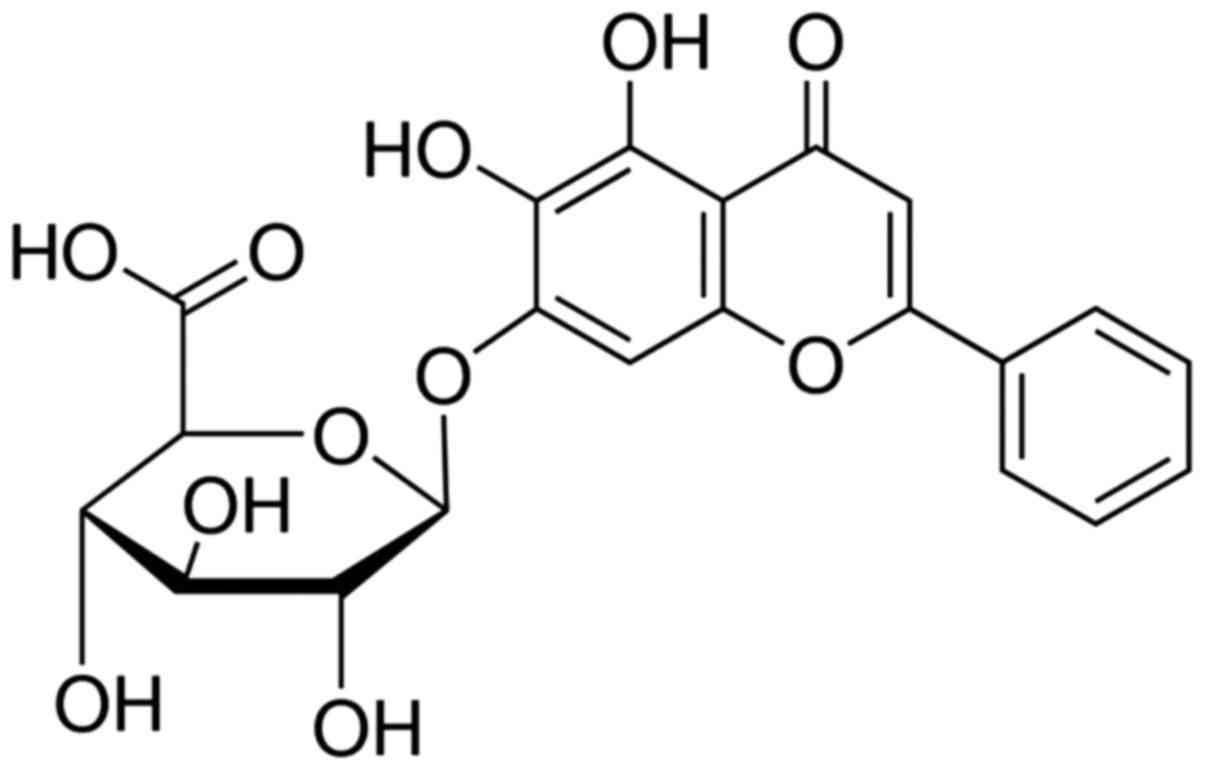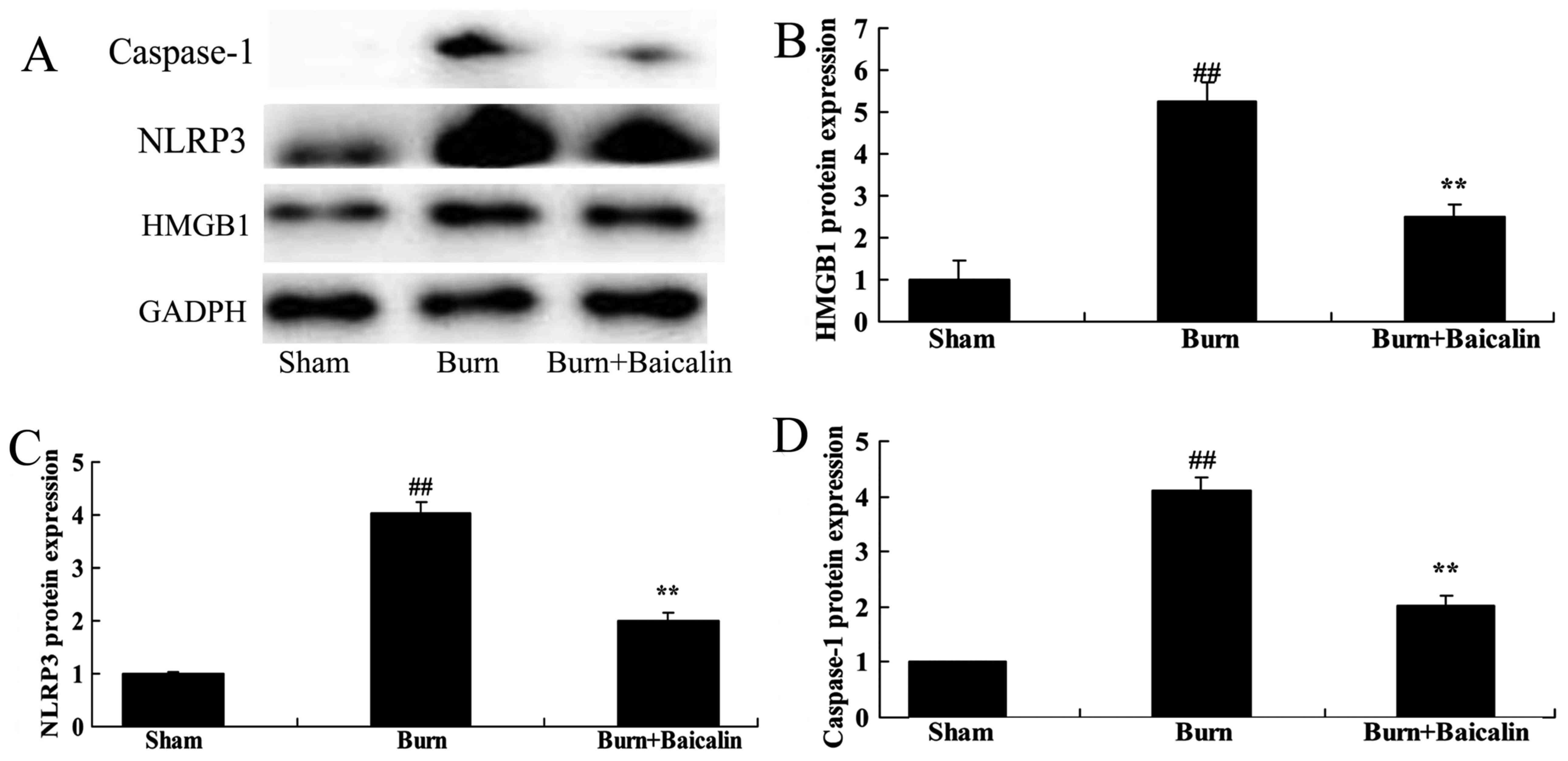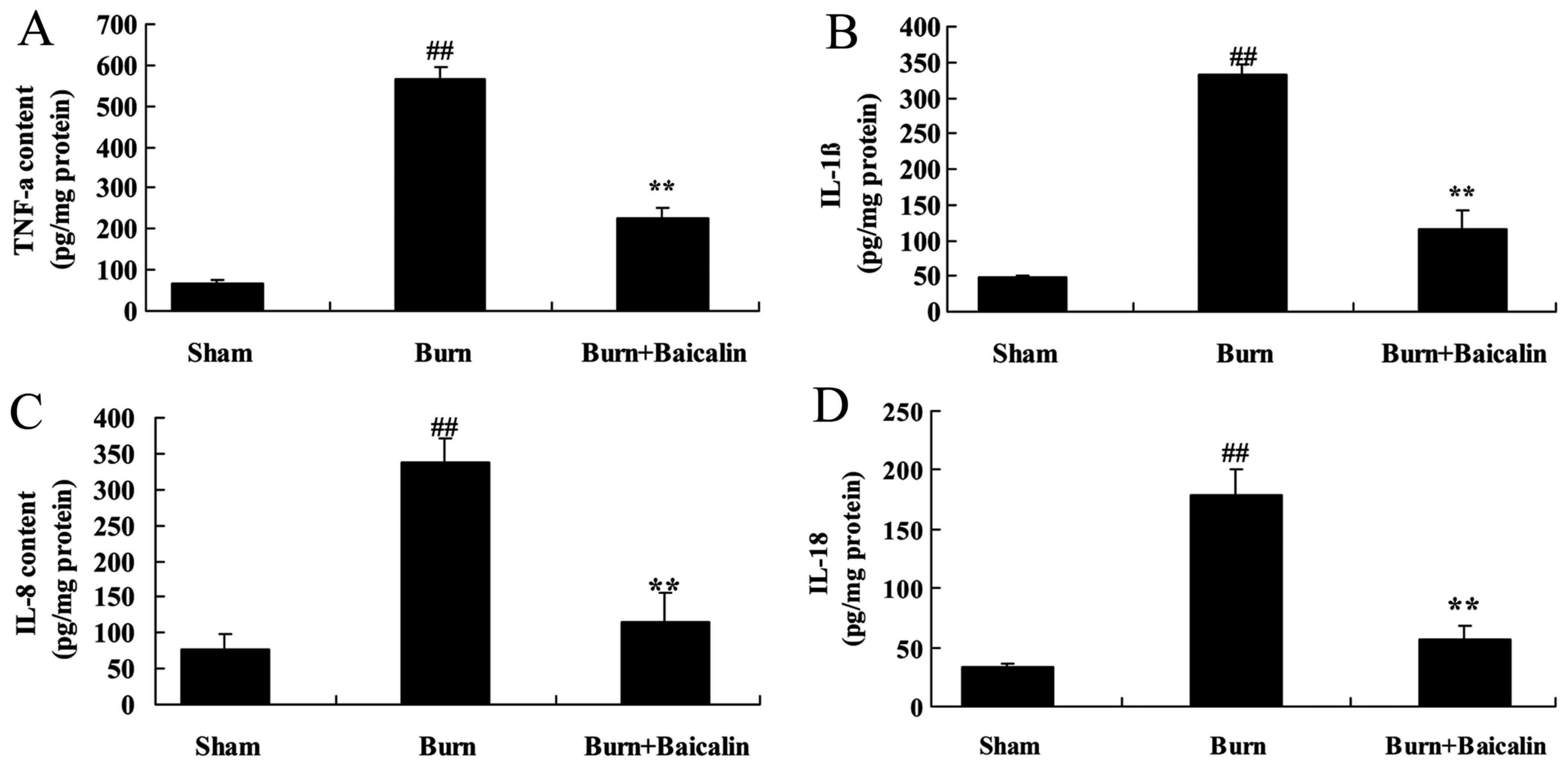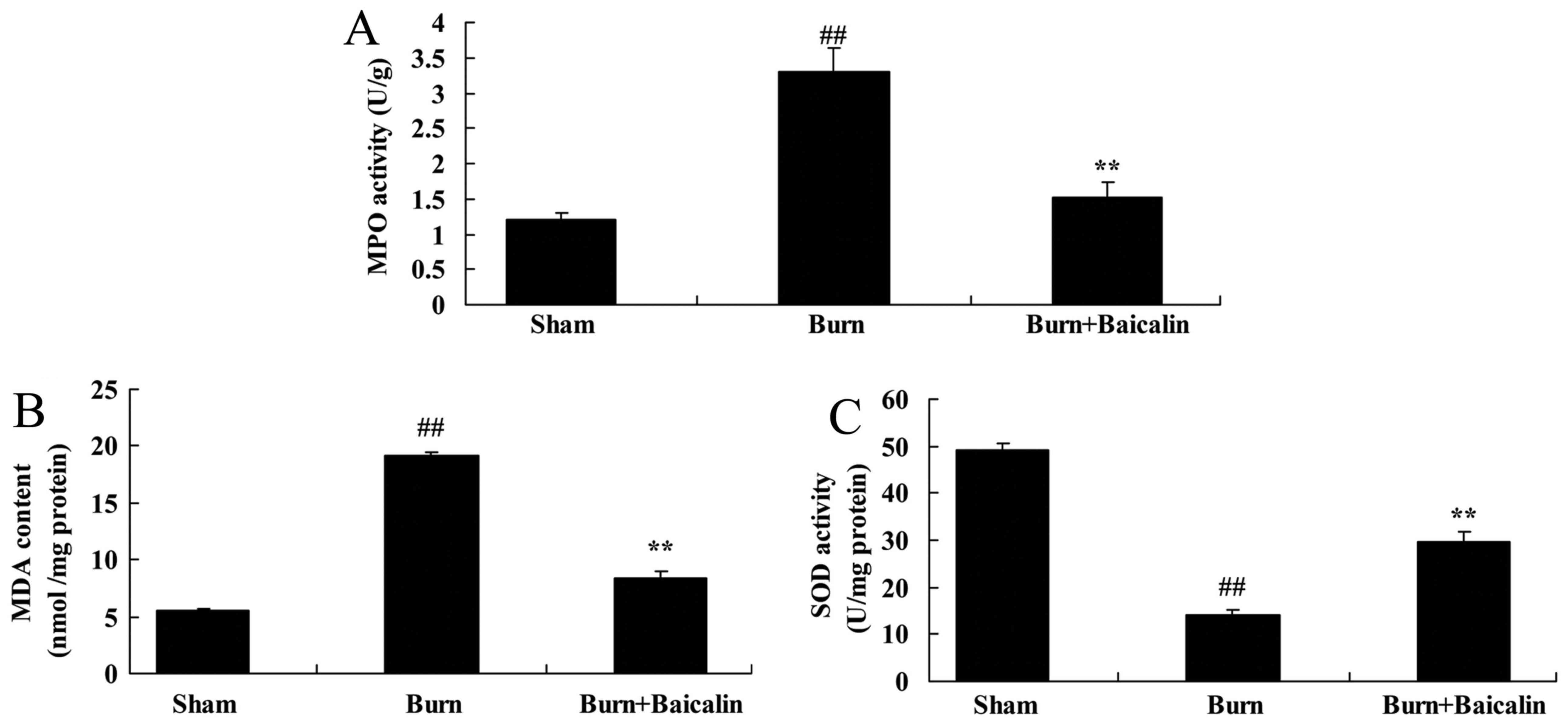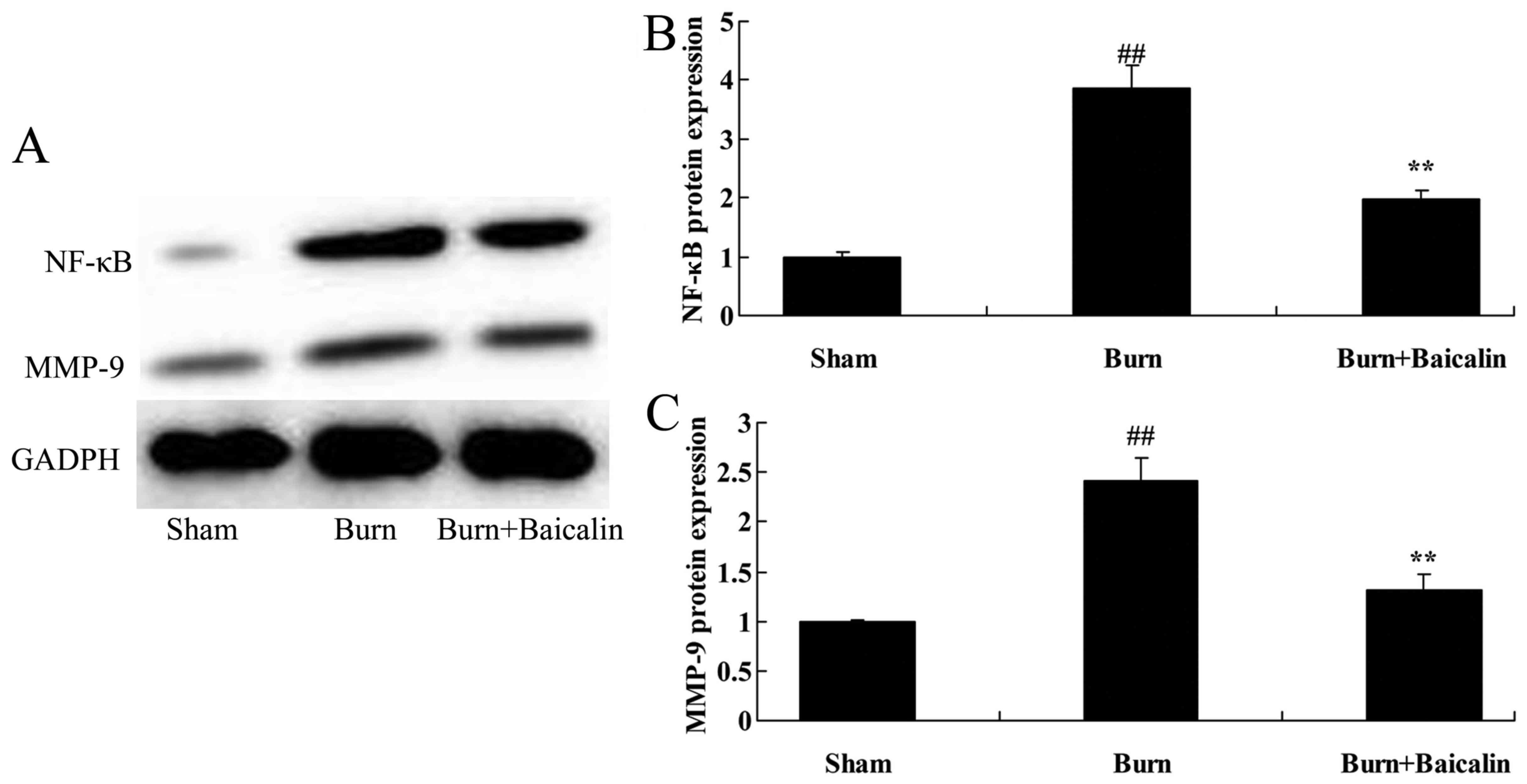Protective effect of baicalin against severe burn‑induced remote acute lung injury in rats
- Authors:
- Published online on: November 20, 2017 https://doi.org/10.3892/mmr.2017.8120
- Pages: 2689-2694
Abstract
Introduction
Acute lung injury (ALI) is a common respiratory in which the symptoms include an increase in pulmonary microvascular permeability, and diffuse pulmonary interstitial and alveolar cavity edema caused by the infiltration of inflammatory cells (1). The primary clinical manifestations of ALI include acute respiratory distress, refractory hypoxemia and non-cardiogenic pulmonary edema. ALI may progress into acute respiratory distress syndrome (ARDS) (2).
ALI and ARDS are the most common complications in patients with a large-area deep burn, particularly when combined with an inhalation injury, shock and delayed resuscitation (3). ALI and ARDS cause body hypoxia, act on various organs and systems of the body, and cause necrosis and dysfunction of tissues, resulting in the development of multiple organ dysfunction syndrome and death. An American epidemiological survey demonstrated that, among patients with severe burns to >30% of the total body area, ARDS is the most common complication, with 26.7–45% incidence and a 40–60% mortality rate (4). ALI and ARDS are the principal diseases threatening the health of severely burned patients, and impose a heavy financial burden on individuals, families and society (2).
NACHT, LRR and PYD domains-containing protein 3 (NLRP3) inflammasomes may be activated by a range of exogenous and endogenous stimuli. Infection with Sendai virus, influenza virus, adenovirus, Saccharomyces cerevisiae, Candida albicans and certain bacteria, including Staphylococcus aureus, Listeria monocytogenes and Shigella flexneri may induce the activation of the NLRP3 inflammasome (5,6). In certain cases, specific microbial components may trigger the activation of the NLRP3 inflammasome to cause ALI (5,7).
Baicalin, additionally termed 5,6,7-trihydroxyflavone (Fig. 1) or baiceli, belongs to a group of flavonoids and is most readily synthesized by the plant species Scutellaria baicalensis (8). Baicalin is a glycoside compound synthesized by the combination of baicalein with a molecule of glucuronic acid, which are also synthesized in skullcap plants. When baicalein enters the body of an animal, it is rapidly transformed into baicalin and other metabolites in the blood. Since the oral absorption of baicalin is challenging, it translocates into the blood via the intestinal tract, aided by enzymatic hydrolysis into baicalein, and is rapidly transformed into baicalinin in vivo. Baicalein has been receiving an increased amount of attention from researchers due to its versatility (9). In the present study, a possible mechanism underlying the neuroprotective effects of baicalin against ALI was investigated.
Materials and methods
Animals and experimental design
Healthy adult female Sprague-Dawley rats (200–230 g; 8–10 weeks old) were acquired from Animal Experiment of Shandong University (Shandong, China) and fed a standard animal diet with food and tap water ad libitum and housed at 23–25°C, 55–60% humidity under a 12 h light/dark cycle. Rats were acclimatized to their environment for at least 1 week prior to the experiment. A total of 30 rats were randomly allocated into one of three groups: i) The sham group (n=6); ii) the burn group (n=12); and iii) the burn + baicalin group (n=12). The rats in the burn + baicalin group were treated with 80 mg/kg of baicalin (Sigma-Aldrich; Merck KGaA, Darmstadt, Germany) for one week. The rats in sham group were treated with normal saline. The present study was approved by the Animal Ethical and Welfare Committee of 401 Hospital of People's Liberation Army (Qingdao, China).
Burn procedure
Rats were intraperitoneally anesthetized with sodium pentobarbital (30 mg/kg), shaved on the dorsal and lateral surfaces and secured on a constructed template device. Hot water (100–95°C) was poured on the dorsal surface of the rat skin for 10 sec to induce burns. Full-thickness dermal burns averaged 30% of the total body surface area.
Lung wet weight to dry weight (W/D) ratio
The upper left parts of lungs were harvested following the sacrifice of rats under anesthesia. The lungs were weighed to record the wet weight and dried in an oven at 75°C for 48 h to record the dry weight. The W/D ratio was calculated as dry/wet weight ×100.
Western blotting analysis
Lung tissue samples were lysed using radioimmunoprecipitation (Beyotime Institute of Biotechnology, Haimen, China) assay lysis buffer at 4°C for 30 min and, following centrifugation at 12,000 × g for 10 min at 4°C, the supernatant was collected and the protein concentration determined using a bicinchoninic acid assay. A total of 50 µg total protein was incubated at 100°C for 10 min and separated on an 8–12% SDS-PAGE gel, blotted onto a polyvinylidene fluoride membrane (EMD Millipore, Billerica, MA, USA), and probed overnight at 4°C with anti-NLRP3 (1:500, sc-66846; Santa Cruz Biotechnology, Inc., Dallas, TX, USA), caspase-1 (1:500, sc-622; Santa Cruz Biotechnology, Inc.), nuclear factor-κB (NF-κB, 1:500; sc-109, Santa Cruz Biotechnology, Inc.) matrix metalloproteinase-9 (MMP-9, 1:500, sc-10737; Santa Cruz Biotechnology, Inc.) and GAPDH (1:2,000, sc-25778; Santa Cruz Biotechnology, Inc.) antibodies following blocking with 5%-non-fat milk in TBST for 1 h at 37°C. Subsequently, the membrane was incubated with an anti-rabbit horseradish peroxidase-conjugated secondary antibody (1:2,000, sc-2030; Santa Cruz Biotechnology, Inc.) at 37°C for 1 h. The membrane was washed and detected using an electrochemiluminescence plus detection kit (GE Healthcare, Chicago, IL, USA) and analyzed using Image_Lab_3.0 (Bio-Rad Laboratories, Inc., Hercules, CA, USA).
Measurement of inflammation and oxidative stress
The serum concentrations of tumor necrosis factor-α (TNF-α, H052), interleukin (IL)-8 (H008), −1β (H002), −18 (H015), myeloperoxidase (MPO, A044), malondialdehyde (MDA, A003-1) and superoxide dismutase (SOD, A001-1-1) were measured using ELISA kits for rats (Nanjing Jiangcheng Bioengineering Institute, Nanjing China), according to the manufacturer's protocols.
Statistical analysis
All data are expressed as the mean ± standard error of the mean. Differences between two groups were analyzed using the Student's t-test, and between more than two groups by one-way analysis of variance followed by a Tukey post-hoc test. P<0.05 was considered to indicate a statistically significant difference.
Results
Effects of baicalin on ALI
To identify the effects of baicalin on burn-induced remote ALI, lung W/D ratio and the pulmonary histological alterations were measured in the present study. The lung W/D ratio and pulmonary histological alterations in burn-induced remote ALI model were increased compared with the sham group (Fig. 2). Treatment with baicalin significantly decreased the lung W/D ratio and improved the pulmonary histological alterations compared with the burn group (Fig. 2).
Effects of baicalin on high mobility group protein B1 (HMGB1) and NLRP3 expression in ALI
The present study evaluated the effects of baicalin on burn-induced remote ALI. HMGB1 protein expression was measured using western blot analysis. As presented in Fig. 3, there was a significant increase in HMGB1, NLRP3 and caspase-1 protein expression in the burn-induced remote ALI model, compared with the sham group. Treatment with baicalin significantly suppressed HMGB1, NLRP3 and caspase-1 protein expression in burn-induced remote ALI rats (Fig. 3).
Effects of baicalin on inflammation in ALI
Inflammatory mediators serve an important role in burn-induced remote ALI. As demonstrated in Fig. 4, TNF-α IL-8, −1β and −18 concentrations in the serum of the burn group were significantly increased compared with the sham group. The increased concentrations of TNF-α, IL-8, −1β and −18 in the serum of the burn group were significantly decreased in the burn + baicalin group (Fig. 4).
Effects of baicalin on the activity of MPO and oxidative stress in ALI
In the burn-induced remote ALI model, MPO activity and MDA content were increased, and SOD expression was decreased, compared with the sham group (Fig. 5). By contrast, treatment with baicalin reduced MPO activity and MDA content, and the increased SOD level in serum in the treated ALI model group, compared with the untreated burn group (Fig. 5).
Effects of baicalin on NF-κB and MMP-9 protein expression in ALI
The effects of Baicalin on the regulation NF-κB and MMP-9 protein expression in ALI were investigated. NF-κB and MMP-9 protein expression in the burn group were significantly increased compared with the sham group (Fig. 6). Treatment with baicalin significantly suppressed the expression of NF-κB and MMP-9 in the burn + baicalin group (Fig. 6).
Discussion
ALI is caused by a variety of non-cardiogenic pulmonary and extrinsic factors, including severe infection, burns, shock, trauma, disseminated intravascular coagulation, aspiration and other primary diseases (10). In the case of multiple organ injuries, ALI develops earliest and its incidence is greatest, making ALI the most common complication of severe burns and delayed resuscitation (1). ALI causes hypoxia and leads to organ damage and dysfunction of distant burn sites, which is one of the leading causes of premature death in patients with burns (11). In the present study, baicalin significantly reduced the lung W/D ratio, improved pulmonary histological alterations and suppressed HMGB1 protein expression in burn-induced remote ALI.
A recent study confirmed that the principal pathological feature of ALI is the formation of protein-rich pulmonary edema and a transparent membrane in the alveolar exudate, caused by an increase in pulmonary capillary permeability, in addition to diffuse alveolar capillary injury caused by uncontrolled inflammation (12). Various causes of injury that lead to the development of ALI stimulate the binding of cell surface receptors by their ligands, triggering signal transduction pathways. The signaling pathways ultimately reach the cell nucleus and stimulate transcription factors to initiate the expression of their target inflammatory mediator genes, including cytokines and chemokines. The resultant uncontrolled inflammation may lead to damage, apoptosis, and mechanical ventilation of alveolar cells and lung capillaries, resulting in lung abnormalities (13).
An uncontrolled inflammatory response is the leading cause of ALI and, therefore, elucidation of the mechanism of action of pulmonary inflammatory mediators in ALI is important for the prevention and treatment of ALI (14). In the present study, baicalin significantly decreased the TNF-α, and IL-8, −1β and −18 concentrations in the serum of rats with burn-induced remote ALI. Liu et al (15) hypothesized that baicalin attenuates inflammation by inhibiting NF-κB in mice with ovalbumin-induced asthma.
An increase in MMP-9 expression in animal models and clinical patients is a common pathophysiological manifestation of lung injury caused by various factors and, therefore, MMP-9 was hypothesized to serve an important role in the development of lung injury (16,17). Analysis of candidate pathways mediating MMP-9 upregulation in ALI demonstrated that an increased level of MMP-9 in lung tissue corresponded with more severe lung injury (16). In the present study, treatment with baicalin significantly suppressed NF-κB and MMP-9 protein expression in rats with burn-induced remote ALI. Yan et al (9) suggested that baicalin may attenuate pulmonary hypertension by downregulating the p38 mitogen-activated protein kinase/MMP-9 pathway.
Inflammasomes are a class of macromolecules and polyprotein complexes induced and assembled via the oligomerization of domain-like receptors, and by activated nucleotide-binding in the cytoplasm of cells (18). Inflammasomes mediate the innate immune response (18). NLRP3 is a member of an inflammatory cytokine family, an apoptosis-associated speck-like protein containing a carboxy-terminal caspase recruiting domain and caspase-1 precursors (19). NLRP3 is activated by the binding of pathogen-associated molecular patterns or risk-associated molecular patterns to their ligands, which induces NLRP3 inflammasome assembly and promotes oligomerization. The resulting oligomerized pro-caspase-1 exhibits self-enzymatic properties to form caspase-1, a biologically active protein that promotes the maturation of IL-1β precursor and IL-18 precursor, additionally termed pro-IL-18, to generate biologically active IL-1β and −18, which are subsequently secreted outside of the cell to exert their biological effects (20). In the present study, baicalin significantly attenuated NLRP3 inflammasome expression in rats with burn-induced remote ALI. Fu et al (21) reported that baicalin suppressed NLRP3 inflammasome and NF-κB signaling in Haemophilus parasuis infection.
In conclusion, the present study identified that baicalin protected against severe burn-induced remote ALI in rats via modulation of the NLRP3 signaling pathway. The positive effects of baicalin on burn-induced remote ALI make it a candidate for application in therapeutic strategies.
Acknowledgements
The present study was supported by the Postdoctoral Application Research Funded Program of Qingdao (grant no. 2015161).
References
|
Sun R, Li Y, Chen W, Zhang F and Li T: Total ginsenosides synergize with ulinastatin against septic acute lung injury and acute respiratory distress syndrome. Int J Clin Exp Pathol. 8:7385–7390. 2015.PubMed/NCBI | |
|
Patel BK, Wolfe KS, Pohlman AS, Hall JB and Kress JP: Effect of noninvasive ventilation delivered by helmet vs face mask on the rate of endotracheal intubation in patients with acute respiratory distress syndrome: A randomized clinical trial. JAMA. 315:2435–2441. 2016. View Article : Google Scholar : PubMed/NCBI | |
|
Zhang Z and Ni H: Prediction model for critically ill patients with acute respiratory distress syndrome. PLoS One. 10:e01206412015. View Article : Google Scholar : PubMed/NCBI | |
|
Shah HA, Dritsaki M, Pink J and Petrou S: Psychometric properties of Patient Reported Outcome Measures (PROMs) in patients diagnosed with Acute Respiratory Distress Syndrome (ARDS). Health Qual Life Outcomes. 14:152016. View Article : Google Scholar : PubMed/NCBI | |
|
Yin N, Peng Z, Li B, Xia J, Wang Z, Yuan J, Fang L and Lu X: Isoflurane attenuates lipopolysaccharide-induced acute lung injury by inhibiting ROS-mediated NLRP3 inflammasome activation. Am J Transl Res. 8:2033–2046. 2016.PubMed/NCBI | |
|
Wang S, Zhao J, Wang H, Liang Y, Yang N and Huang Y: Blockage of P2×7 attenuates acute lung injury in mice by inhibiting NLRP3 inflammasome. Int Immunopharmacol. 27:38–45. 2015. View Article : Google Scholar : PubMed/NCBI | |
|
Jiang W, Li M, He F, Bian Z, Liu J, He Q, Wang X, Sun T and Zhu L: Dopamine D1 receptor agonist A-68930 inhibits NLRP3 inflammasome activation and protects rats from spinal cord injury-induced acute lung injury. Spinal Cord. 54:951–956. 2016. View Article : Google Scholar : PubMed/NCBI | |
|
Yang LL, Xiao N, Liu J, Liu K, Liu B, Li P and Qi LW: Differential regulation of baicalin and scutellarin on AMPK and Akt in promoting adipose cell glucose disposal. Biochim Biophys Acta. 1863:598–606. 2017. View Article : Google Scholar : PubMed/NCBI | |
|
Yan S, Wang Y, Liu P, Chen A, Chen M, Yao D, Xu X, Wang L and Huang X: Baicalin attenuates hypoxia-induced pulmonary arterial hypertension to improve hypoxic cor pulmonale by reducing the activity of the p38 MAPK signaling pathway and MMP-9. Evid Based Complement Alternat Med. 2016:25464022016. View Article : Google Scholar : PubMed/NCBI | |
|
Craig TR, Duffy MJ, Shyamsundar M, McDowell C, O'Kane CM, Elborn JS and McAuley DF: A randomized clinical trial of hydroxymethylglutaryl-coenzyme a reductase inhibition for acute lung injury (The HARP Study). Am J Respir Crit Care Med. 183:620–626. 2011. View Article : Google Scholar : PubMed/NCBI | |
|
Qiu ZQ and Zhao K: Expression of ERCC1, RRM1 and LRP in non-small cell lung cancers and their influence on chemotherapeutic efficacy of gemcitabine concomitant with nedaplatin. Asian Pac J Cancer Prev. 15:7303–7307. 2014. View Article : Google Scholar : PubMed/NCBI | |
|
Hoeboer SH, Groeneveld AB, van der Heijden M and Oudemans-van Straaten HM: Serial inflammatory biomarkers of the severity, course and outcome of late onset acute respiratory distress syndrome in critically ill patients with or at risk for the syndrome after new-onset fever. Biomark Med. 9:605–616. 2015. View Article : Google Scholar : PubMed/NCBI | |
|
Onorati F, Santini F, Mariscalco G, Bertolini P, Sala A, Faggian G and Mazzucco A: Leukocyte filtration ameliorates the inflammatory response in patients with mild to moderate lung dysfunction. Ann Thorac Surg. 92:111–121. 2011. View Article : Google Scholar : PubMed/NCBI | |
|
Samransamruajkit R, Jiraratanawong K, Siritantiwat S, Chottanapan S, Deelodejanawong J, Sritippayawan S, Prapphal N and Poovorawan Y: Potent inflammatory cytokine response following lung volume recruitment maneuvers with HFOV in pediatric acute respiratory distress syndrome. Asian Pac J Allergy Immunol. 30:197–203. 2012.PubMed/NCBI | |
|
Liu J, Wei Y, Luo Q, Xu F, Zhao Z, Zhang H, Lu L, Sun J, Liu F, Du X, et al: Baicalin attenuates inflammation in mice with OVA-induced asthma by inhibiting NF-κB and suppressing CCR7/CCL19/CCL21. Int J Mol Med. 38:1541–1548. 2016. View Article : Google Scholar : PubMed/NCBI | |
|
Chao W, Deng JS, Huang SS, Li PY, Liang YC and Huang GJ: 3,4-dihydroxybenzalacetone attenuates lipopolysaccharide-induced inflammation in acute lung injury via down-regulation of MMP-2 and MMP-9 activities through suppressing ROS-mediated MAPK and PI3K/AKT signaling pathways. Int Immunopharmacol. 50:77–86. 2017. View Article : Google Scholar : PubMed/NCBI | |
|
He W, Jiang J, Yu ZQ and Zhou JH: Novel 5-hydroxy, 5-substituted benzenesulfonamide pyrimidine-2,4,6-triones attenuate lipopolysaccharide-induced acute lung injury via inhibition of the gelatinases, MMP-2 and MMP-9. Drug Dev Res. 77:251–257. 2016. View Article : Google Scholar : PubMed/NCBI | |
|
Mizushina Y, Shirasuna K, Usui F, Karasawa T, Kawashima A, Kimura H, Kobayashi M, Komada T, Inoue Y, Mato N, et al: NLRP3 protein deficiency exacerbates hyperoxia-induced lethality through Stat3 protein signaling independent of interleukin-1β. J Biol Chem. 290:5065–5077. 2015. View Article : Google Scholar : PubMed/NCBI | |
|
Luo YP, Jiang L, Kang K, Fei DS, Meng XL, Nan CC, Pan SH, Zhao MR and Zhao MY: Hemin inhibits NLRP3 inflammasome activation in sepsis-induced acute lung injury, involving heme oxygenase-1. Int Immunopharmacol. 20:24–32. 2014. View Article : Google Scholar : PubMed/NCBI | |
|
Fukumoto J, Fukumoto I, Parthasarathy PT, Cox R, Huynh B, Ramanathan GK, Venugopal RB, Allen-Gipson DS, Lockey RF and Kolliputi N: NLRP3 deletion protects from hyperoxia-induced acute lung injury. Am J Physiol Cell Physiol. 305:C182–C189. 2013. View Article : Google Scholar : PubMed/NCBI | |
|
Fu S, Xu L, Li S, Qiu Y, Liu Y, Wu Z, Ye C, Hou Y and Hu CA: Baicalin suppresses NLRP3 inflammasome and nuclear factor-kappa B (NF-κB) signaling during Haemophilus parasuis infection. Vet Res. 47:802016. View Article : Google Scholar : PubMed/NCBI |



